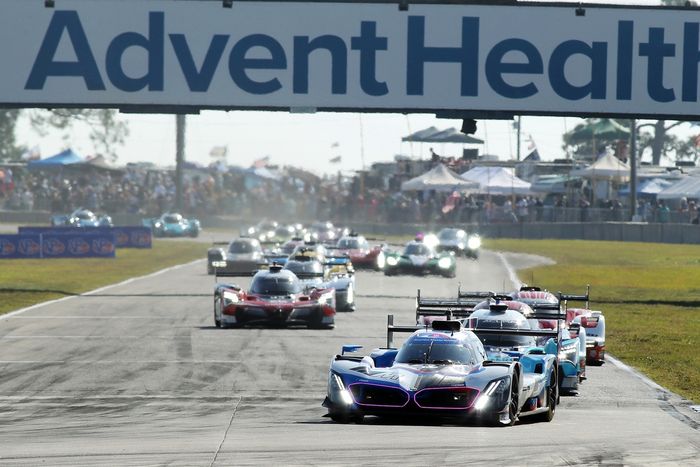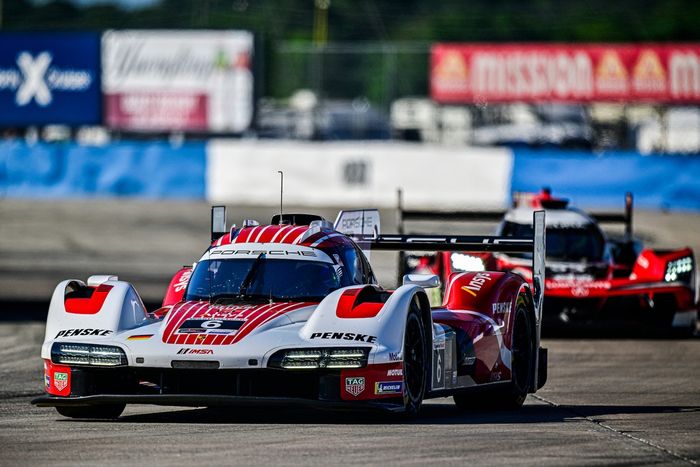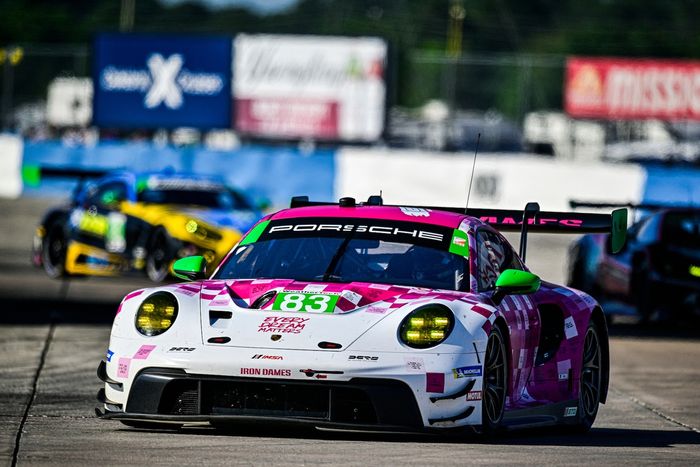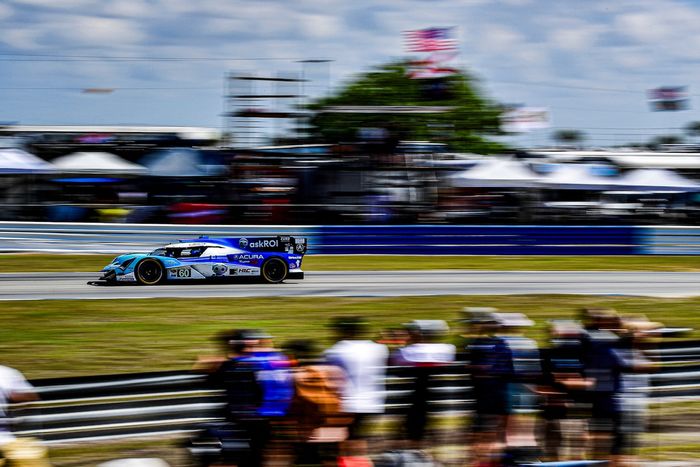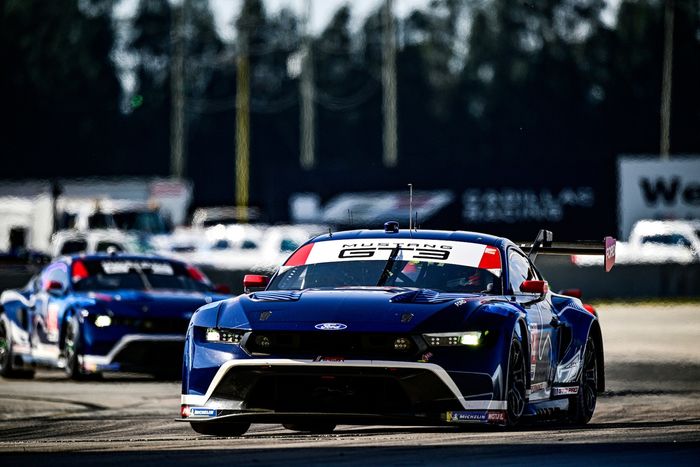
It’s Friday afternoon of the 12 Hours of Sebring race weekend and Nico Mueller had at this point put 30 laps on the Porsche 963 of JDC Miller Motorsports. Those would be the only laps he’d put on that car before race day as the team prioritized setup for Gianmaria Bruni’s qualifying laps just a couple hours before (9th on the grid for Saturday’s race). The difference was that Mueller was joining Brunia and Tijmen van der Helm as a third for the race, running the 963 for his very first time.
He’s not unprepared for it. No, he read the 67-page manual on how to operate the car’s complex steering wheel, at least a couple of times. He’s also not unfamiliar with Sebring, necessarily, or driving a GTP car. But the combination of a complex track and a learning a different, incredibly complex machine and system, presents its own challenge.
“If there's one place [that’s] difficult to really get the hang of a new car with these circumstances, with the traffic, it's maybe Sebring,” Mueller shared in an interview with Motorsport.com. “Because to find a bit of a rhythm is obviously very difficult with the amount of cars we have [in] the different classes [and] the track itself is already pretty challenging. It's a handful.”
Mueller might not have meant that literally, yet operating a complex hybrid machine with a steering wheel that comes with a 67-page manual does sound like a handful.

But the wheel is a tool for the 33-year-old Swiss driver… able to further fine tune the car that the JDC Miller Motorsports crew have already tuned to compliment the track, conditions, and its three drivers set to take the wheel. The prototypes in this case already have some of the braking zones programmed for drivers, especially as they need to switch between mechanical and regenerative braking. Where the wheel and its dozens of buttons come in is to finesse the inputs further and fine tune how the systems respond if they need it.
”You can pre-program lots of it, and in a perfect world, you don't need to change much from within the car. But you definitely do. You can change whilst you're out there driving, if you want. You can change corner by corner, but it's a bit too complex.
“Let's say because obviously it's a lot of fiddling around on the steering wheel, and you rather look where you're going and all that traffic. So I think it's more of a general tuning that you can do, as the stint goes on. But you aim to go into the race to have a baseline that's pre-programmed, where you go like, okay, that's gonna work in most conditions to a good level, and then you tune slightly from there.”
At first glance, it would seem like the system wouldn’t be as complicated to adjust to, as Mueller has been at the helm of a GTP car before (with Peugeot in WEC), and has vast experience fine-tuning the electric systems via wheel in the Formula E series. But the GTP is a fairly different beast from the Formula E cars he’s piloted for almost a decade. The tuning adjustments in some cases are similar, but the nature of the beast and how to operate it when it comes to making pace is incredibly different.
“The Formula (E) car is very complex, but there you then talk in very fine margins. So you can easily fall slightly out of the window [optimal performance for the car], but you're then going to be two- to three-tenths off. I feel like with these [GTP LMH] cars, if you are falling out of the window and you're not figuring out what to do to get back closer to the window or into it … you're very easily gonna drive about a second off the pace and and you're not driving any worse. You just kind of start to get into that vicious circle.
“I've experienced that, unfortunately in the Peugeot as well, and I know it's because I have done many, you know, tests and stuff with them, and you figure out how the systems can be used to kind of limit the problems you have and and suddenly, from one lap to the next, you find half a second just because of doing two, three clicks on the right parameter.”

Then there’s the challenge of taming the track… or rather taming the car, especially one that’s new to you, to take on the track. The first turn being one of the most unforgiving at Sebring. Its bumpy, semi-warped surface coming off the front straight forces drivers to choose from two ideal lines, one rather tight on the apex, or the wide line you might see the occasional car take on the far end of the turn. The wide part also serves as a blend lane for cars rejoining traffic from pit lane, which further adds to the chaos. Find yourself in the middle and you’ve set yourself up for a possible wild ride heading through and into Turn 2. Mueller takes us through the corner from his seat:
“...it's very unique. Because one thing is the bumps obviously kind of make make you, or give you very limited choices with your lines. So yes, you can choose how you do your inputs with the pedals, or, you know, simply said, how you put your loads. You can still influence that.
“But the way you place the car on the way in — you don't have much choice, because If you go too tight or too wide, you unsettle the car just because you hit the bump differently. So you're very tight, tied down with with your options. And on other tracks very often, when the car behaves differently to what you expect, you can also adjust the line, because bumps are not such a problem. And here you don't really have that option.
“I mean, on the way in, sometimes I think it's a compromise between how late and how much combined. Do I try and break? Or do I anticipate braking a bit, pop off the brake and then turn? But it really depends on your car balance. If you need the bit of load on the front to be able to rotate, obviously, try and delay that braking into the corner, which can easily create a bit of instability over the curb. So it's always that trade off. It depends, really, where your car balances.
“And then you have to understand and figure out with your driving, how do I use what I have to find the best compromise? AndI think that's different for everyone, every car, and it changes from hour to hour.”

While you can predict how a track might react in an IMSA sprint race (100 minutes to 2 hours and 40 minute times), Sebring’s 12 hours begin just before high noon and trail into the night lending to a fluctuating track temperature between several degrees (sometimes well over 10 Fahrenheit). Track conditions in your earlier stint will be very different than your next, so any adjustments and tweaks you’ve made — any tricks you’ve figured out and established — will change and evolve once again. A new literal road to discovery.
Mueller clocked just over three and a half hours in the car, shared between the two cars, across the 12-hour race, applying every little lesson he learned in his first 30 laps, and through his breadth of experience racing. He’d be the one to take the car home across the finish for the #85 JDC Miller Motorsports Porsche 963 to 8th overall and within an incredibly competitive category.








